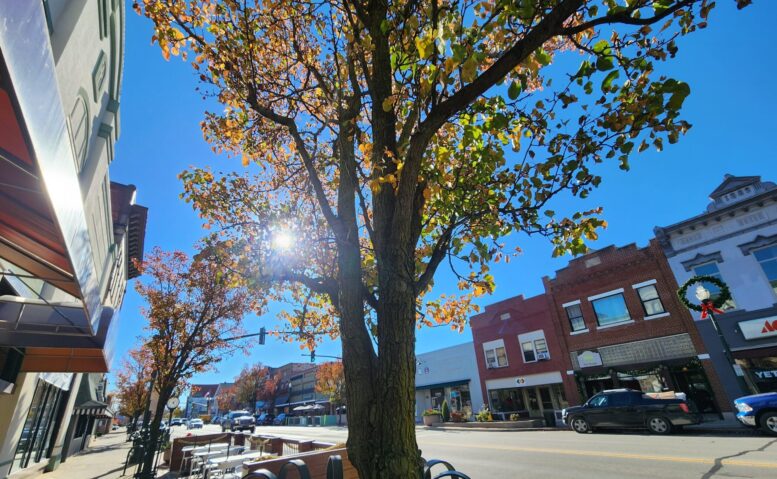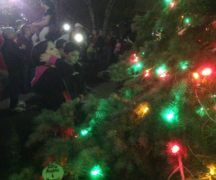By JAN LARSON McLAUGHLIN
BG Independent News
Many of the trees dotting downtown Bowling Green will soon be toppled. But tree huggers fear not – the streetscape won’t remain bare long. The trees will be replaced with new trees that are more durable and less invasive.
Beginning the week of Nov. 20, the city will begin the process of removing and replacing the Callery pear trees in the Downtown Bowling Green streetscape.
The trees are being removed for multiple reasons, according to BG City Arborist Adrien Lowien-Kirian. First, the pear trees have outgrown their space, and are encroaching on businesses. Second, many of the pear trees, which are nearing their estimated lifespan of 25 years, are not healthy and are losing branches, which can be a problem in an area with many pedestrians and parked vehicles.
But perhaps most importantly, the Callery pear trees have been declared a banned invasive species in Ohio – making is illegal to produce, plant or sell them in the state.
The pear trees were originally planted in Bowling Green’s downtown as part of the Heritage 2000 project. For a period, the Callery pears were a darling of tree projects in Ohio. They were fast-growing and featured white blossoms in the spring.
However, their popularity waned when the invasive pear species started overtaking native species of trees. Beginning in January 2023, Callery pear was added to the list of banned invasive plants in Ohio, making it illegal to produce, plant, or sell these trees in the state.
So 26 of the trees lining the downtown streetscape will be replaced with Princeton Sentry Ginkgo trees and Street Keeper Honeylocust trees.
According to Lowien-Kirian, the replacement species were selected for their tolerance to the environment found along city streets. They can thrive with limited soil conditions, and have high tolerance to pollution, salt and abuse from humans, she said.
The ginkgo and honeylocust trees also only mature to 20-30-feet wide, meaning they won’t be fighting with buildings for space. And their lifespans are closer to 50 years, Lowien-Kirian said.
The benefits of street trees in downtown areas are many, the arborist said. Trees sequester carbon from car exhaust, they recirculate water runoff, and they provide shade.
“It really helps keep the temperature cooler on the sidewalks and streets,” she said.
And studies have shown that people are likely to spend more time in downtown or other shopping areas that are lined with trees, Lowien-Kirian said.

The removal and replacement of 26 trees will take several weeks to complete. Crews will begin by removing the metal tree guards from the base of the trees. Then the pear trees will be removed, the stumps will be ground out, and the new trees of 8-10 feet will be planted.
The tree removal and replacement project is expected to cost about $10,000.
The plan is to work on one side of the street at a time, to reduce interruptions to pedestrian and vehicle traffic as much as possible, Lowien-Kirian said. Intermittent parking restrictions and possible lane closures on Main Street may be necessary as the project progresses.
“It will be such a great thing to get those invasive trees out of there,” she said.
“They used to be really popular once they were first developed,” but the Callery pear trees quickly germinated. “They started becoming very invasive.”
An invasive species is a non-native species that causes harm to the environment, economy, human, animal, or plant health. Callery pear trees are particularly invasive because they spread and reproduce so easily that they overtake natural areas and choke out other desirable native species. Cultivars and varieties of Callery pears include Cleveland select, Whitehouse, Bradford, among others.
The ban does not regulate existing plants, so Bowling Green residents should not panic if this tree is currently planted on their property, Lowien-Kirian said. However, removal of existing trees will aid in the reduction of the spread of this plant. Over time, the city’s arborist will be strategically removing and replacing Callery pears that are planted on city property and rights-of-way.





